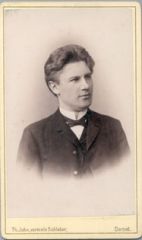![]()
![]()
![]()
Use LEFT and RIGHT arrow keys to navigate between flashcards;
Use UP and DOWN arrow keys to flip the card;
H to show hint;
A reads text to speech;
10 Cards in this Set
- Front
- Back

Reinhold Seeberg (who)
|
1859-1935, German Protestant theologian
professor of NT, church history, and systematic theology at U. of Erlangen. 1898, professor of systematic theology at U. of Berlin Supervisor of D. Bonhoeffer |
|
|
Claims Jesus as Arian
|
*Claimed Jesus was Aryan
(1) Between 1800 and 1870 influential intellectuals present the idea that Jesus was not a Jew racially (Johann Gottlieb Fichte and Schopenhauer, Richard Wagner, etc). Between 1870 and 1918, these ideas systematically developed and disseminated including Orientalists (such as Paul Main and Friedrich Delitzsch) and in 1918 the first university theologian (Reinhold Seeberg, the supervisor Dietrich Bonhoeffer), they propagate Aryan" Jesus. Martin Leutzsch, Zeitschrift für Theologie und Kulturgeschichte bd. 2, Conference Session "Theology and Vergangenheitsbewältigung II Catholicism French - German Protestantism, 1930-1950" of 12 to 14 January 2007: The Myth of the Aryan Jesus |
|
|
Seeberg (methodology)
|
positivist historical approach; history of dogma is historical theology.
Voluntarism - reason to faith, exercise of will. Rejects general and special divisions history of doctrine (ala Baur and Hagenbach). All doctrinal development occurs within history, not outside of it. |
|
|
Seeberg (hates)
|
Opponent of:
E. Troeltsch A. von Harnack--gospel essence is corrupted by hellenism, which leads to unwarranted church structures and dogma for the purposes of control. Reformation, specifically Luther, attempt to get back to the essence. FC Baur--hegelian who held that doctrine developed as a synthesis of Judaism and hellenism. Thomasius--confessional Lutheran arguing that medieval theology corrupted patristic doctrine which incited the Reformation (specifically Lutheranism) as the corrective. Roman Catholic perversion of Doctrine by Dogma, Lutheran Protestantism in the religion of "Pure Doctrine" Seeberg's critique of modernity mingled anti-liberalism with anti-semitism. |
|
|
Seeberg (universe of scholarship)
|
*Seeberg positions himself against:
-Roman Catholics by claiming there is no Divine dogma (history proves conflicts between dogma) -Rationalists by claiming that dogma has doesn't have error simply because it is ancient -Baur by claiming that dogma has doesn't have error simply because it marks the tansition to the spirit of modern times -Harnack by claiming that dogma has doesn't have error simply because it has hellenistic connections (which Seeberg says it does) -Thomasius by claiming that the history of doctrine does not have as its telos the justification of the Lutheran confessions. |
|
|
Seeberg (Thesis)
|
Protestant Lutheranism continues through scientific inquiry, to revive the pure doctrine of the primitive church, and the importance of justification and forgiveness of sins, while resisting the ecclesial accretions of dogma and works righteousness.
|
|
|
Seeberg (dogma)
|
Ecclesiastical doctrine or doctrines; doctrines that have arisen to ecclesiastical status.
Dogma is fallible. It includes ecclesiastic doctrines up to the Reformation (contra Harnack) but not the doctrine of every (major) group (contra Baur, e.g., Socinians) |
|
|
Seeberg (periods of development 1)
|
1) The Construction of Doctrine in the Ancient Church
-theological and ecclesiastical developments of the primitive church - early church struggles with pure doctrine by losing sight of justification and forgiveness of sins (79-80), by adding works to grace (80), and conflict between tradition and succession (81) -development of hellenized dogma--Trinity, Christ, Images--with similar developments in the Eastern church -Augustine's theology of sin, grace and the church systematizes dogma for the Western church |
|
|
Seeberg (periods of development 2)
|
2) The Preservation, Transformation, and Development of Doctrine in the Church of the Middle Ages
-emasculated Augustinianism conserved until the 11th C. -Scholastic influences on dogma--legitimate (theology, atonement, sacraments, and the church) and perversions (the dissolution of Augustinianism, Hierarchism). 3) The Development of the Doctrinal System through the Reformation, and the Opposing Crystallization of Doctrine by Roman Catholicism -symbolic fixation of Luther and Zwingli on dogma -doctrinal controversy up through F. of Concord and S. of Dort -Rom. Catholic conservation of medieval dogma with Trent, Episcopalism, Vatican, etc. |
|
|
Seeberg (essence of Christianity)
|
"The redemptive dominion of God and faith, the kingdom of God and love--this is the briefest possible expression of the Essence of Christianity in the sense of the NT" (Seeberg)
This seems very close to Ritschl and kinda close to Harnack. |

